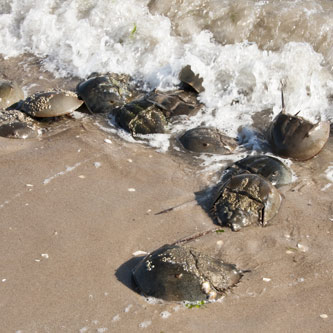Health of Jamaica Bay Wetlands Is Focus of Brooklyn College Symposium
April 6, 2012

Horseshoe crabs emerge from Jamaica Bay.
Hundreds of species call Jamaica Bay home, but decades of development in the surrounding area are threatening their habitat. Although much work has been done to restore its natural state, there is much yet to be accomplished. Scientists from Brooklyn College are seeking solutions.
Recently, the college hosted the latest in a series of scientific symposia sponsored by the National Park Service and underwritten by the New York City Department of Environmental Protection. Speakers at "State of the Bay: Past, Present and Future — Revisited" included several faculty from Brooklyn College along with more than a dozen academicians and researchers from environmental agencies throughout the New York area.
Situated on the southwestern tip of Long Island and connected with Lower New York Bay via the Rockaway Inlet, Jamaica Bay is a nutrient-rich estuary that lies in the midst of the metropolitan area. It covers 25,000 acres and is surrounded by residential, commercial and industrial development in the city's boroughs of Brooklyn and Queens as well as the Nassau County town of Hempstead.
Jamaica Bay's location and rich food resources make it an important fish, wildlife and plant habitat. Once the source of copious harvests of oysters, clams and other seafood, it is still home to more than 330 bird species — about half of all bird species in North America — and a major stop along the north-south migratory route for birds. In addition, the bay is home to an impressive array of native reptiles, amphibians and small mammals; more than 60 species of butterflies; and one of the largest populations of horseshoe crabs on the East Coast.
Two assistant professors from the Department of Earth and Environmental Sciences discussed some of the ongoing research into Jamaica Bay that is under way at Brooklyn College.
Zhongqi "Joshua" Cheng monitors 17 pilot projects at 11 locations in Brooklyn and Queens. His tracking is meant to identify which of the various catchment measures are most effective at reducing water overflows into the city's sewer system during storm events. Such overflows frequently end up in the waters of Jamaica Bay, where they introduce toxins such as heavy metals, nitrates and other materials.
Brett Branco described how a number of organizations interested in the environment of Jamaica Bay frequently produce datasets that present confusing conclusions. "We can improve the quality and consistency of data," he said, "by coordinating our methods as recommended in the Jamaica Bay Watershed Protection Plan of 2005." He also recommended that organizations and institutions lean more heavily on the many students in the New York area as research assistants and field workers.
Denise J. Reed, a research professor with the Department of Earth and Environmental Sciences at the University of New Orleans, delivered the event's keynote address.
"The news is not good," she said. According to the latest report on the status of wetland systems across the United States, "despite our best efforts, we are still in negative numbers nationally, with the state of wetlands declining since the middle of the decade at a rate three times greater than during the period from 1998 to 2004."
Other researchers from Brooklyn College and organizations throughout the New York metropolitan area told the audience about efforts to restock the bay's huge harvests of oysters, plans to replant eelgrass and other water plants throughout the bay, the salinity of the bay's waters, the pollutants in its soils and sediments and the growing danger from the predicted rise in sea levels.






